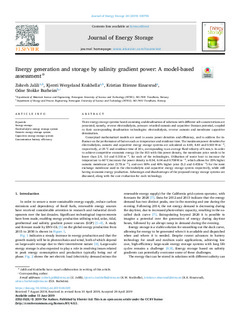| dc.contributor.author | Jalili, Zohreh | |
| dc.contributor.author | Krakhella, Kjersti Wergeland | |
| dc.contributor.author | Einarsrud, Kristian Etienne | |
| dc.contributor.author | Burheim, Odne Stokke | |
| dc.date.accessioned | 2019-11-04T07:57:55Z | |
| dc.date.available | 2019-11-04T07:57:55Z | |
| dc.date.created | 2019-06-12T21:57:36Z | |
| dc.date.issued | 2019 | |
| dc.identifier.citation | Journal of Energy Storage. 2019, 24 1-22. | nb_NO |
| dc.identifier.issn | 2352-152X | |
| dc.identifier.uri | http://hdl.handle.net/11250/2626248 | |
| dc.description.abstract | Three energy storage systems based on mixing and desalination of solutions with different salt concentrations are presented, namely, reverse electrodialysis, pressure retarded osmosis and capacitive Donnan potential, coupled to their corresponding desalination technologies: electrodialysis, reverse osmosis and membrane capacitive deionisation.
Conceptual mathematical models are used to assess power densities and efficiency, and to address the influence on the performance of factors such as temperature and residence time. The maximum power densities for electrodialysis, osmotic and capacitive energy storage systems are calculated as 4.69, 4.83 and 0.503 W m−2, respectively, at 25 °C and residence time of 20 s, corresponding to an average fluid velocity of 5 mm/s. In order to achieve competitive economic energy (in the EU) with this power density, the membrane price needs to be lower than 2.9, 3.0 and 0.31$ m−2, for each of the technologies. Utilisation of waste heat to increase the temperature to 60 °C increases the power density to 8.54, 6.04 and 0.708 W m−2, which allows for 25% higher osmotic membrane price (3.7$ m−2), and over 80% and 40% higher price (5.2 and 0.43$ m−2) for the ionic exchange membrane used in the electrodialytic and capacitive energy storage system respectively, while still having economic energy production. Advantages and disadvantages of the proposed energy storage systems are discussed, along with the cost evaluation for each technology. | nb_NO |
| dc.language.iso | eng | nb_NO |
| dc.publisher | Elsevier | nb_NO |
| dc.rights | Navngivelse 4.0 Internasjonal | * |
| dc.rights.uri | http://creativecommons.org/licenses/by/4.0/deed.no | * |
| dc.title | Energy generation and storage by salinity gradient power: A model-based assessment | nb_NO |
| dc.type | Journal article | nb_NO |
| dc.type | Peer reviewed | nb_NO |
| dc.description.version | publishedVersion | nb_NO |
| dc.source.pagenumber | 1-22 | nb_NO |
| dc.source.volume | 24 | nb_NO |
| dc.source.journal | Journal of Energy Storage | nb_NO |
| dc.identifier.doi | 10.1016/j.est.2019.04.029 | |
| dc.identifier.cristin | 1704492 | |
| dc.description.localcode | © 2019 The Authors. Published by Elsevier Ltd. This is an open access article under the CC BY license (http://creativecommons.org/licenses/BY/4.0/). | nb_NO |
| cristin.unitcode | 194,66,35,0 | |
| cristin.unitcode | 194,64,25,0 | |
| cristin.unitname | Institutt for materialteknologi | |
| cristin.unitname | Institutt for energi- og prosessteknikk | |
| cristin.ispublished | true | |
| cristin.fulltext | original | |
| cristin.qualitycode | 1 | |

